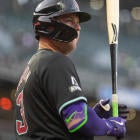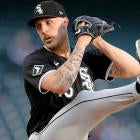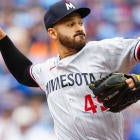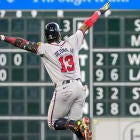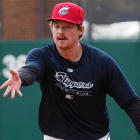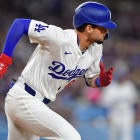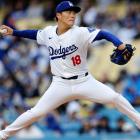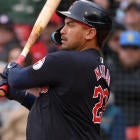- Draft Prep Tiers: C | 1B | 2B | SS | 3B | OF | SP | RP
- Heath's Sleepers | Breakouts | Busts |
- Scott's Top 100 prospects | Sleepers | Breakouts | Busts
Let's talk about a player who in his first full season as a major-leaguer took the league by storm.
Despite a minor-league track record that was more good than great, he stepped onto the field and was absolutely dominant, putting together an MVP-caliber season with league-leading home run and run-production numbers, and a healthy average despite some strikeout concerns. He managed that feat thanks to being a historical outlier in batted-ball data, a sign that this massive rookie season wasn't just some fluke.
If you read the headline, you know I'm probably talking about Ryan Howard. Or Aaron Judge. Both, really.
Howard wasn't a rookie in his breakout season, but played just 88 games the previous season, so 2006 was his first real chance to show what he could do for a full season as a 26-year-old. Judge was a year younger in 2017, and didn't have quite as much experience as Howard, though his breakout season was also even more of an outlier based on his minor-league and major-league track record to date.
Both are also gargantuan human beings who physically towered over the competition, though it's worth noting that for this comparison's sake, the 6-foot-4, 250-pound Howard can't even manage to measure up to Judge:
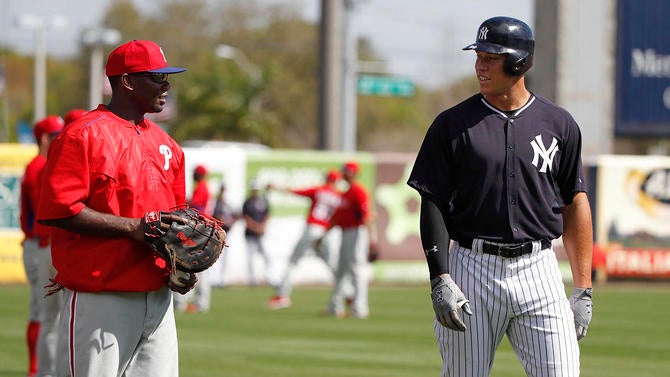
Still, Howard was plenty big, and he was just about the best player we've seen at leveraging that size into game power. If you thought Judge's 35.6 percent HR/FB rate last season made him an outlier, consider Howard's 39.5 percent mark in that 2006 season.
All told, these two players were about as similar as two could be. Here are the relevant numbers:
| Season | Name | PA | HR | R + RBI | BB% | K% | BABIP | LD% | GB% | FB% | HR/FB | SwStr% | Pull% | Soft% | Med% | Hard% |
| 2006 | Ryan Howard | 704 | 58 | 253 | 15.30% | 25.70% | 0.356 | 21.70% | 42.10% | 36.20% | 39.50% | 14.20% | 46.60% | 8.10% | 47.00% | 44.80% |
| 2017 | Aaron Judge | 678 | 52 | 242 | 18.70% | 30.70% | 0.357 | 21.90% | 34.90% | 43.20% | 35.60% | 13.30% | 41.40% | 11.20% | 43.50% | 45.30% |
Judge struck out a bit more, but he also walked a bit more. Howard hit fewer flyballs, but hit them to the pull side a bit more often and hit them hard a bit more often, which explains some of his edge in homers. No two players are perfect comps for each other – Judge is a much better athlete, for one thing – but this is about as close as you're going to come to finding a comp for Judge, especially in the batter's box. And especially given how dominant both were in their first full season.
What is instructive about this example is that, despite his relative youth at the time, Howard never bested his breakout season. In fact, he never even came close to matching it. His batting average dropped 45 points from 2006 to 2007, and his home run total dropped by 11. Over the next three seasons, he would hit .266, while averaging 47 homers per season, with elite RBI and run production numbers, tons of walks, and tons of strikeouts. He was very good, but he was never as good as he was in 2006, because he maximized his skill set in that first season.
Judge may not follow the same path, but Howard is a good example of why we may have already seen the best of Judge. Not necessarily because his skill set is on the verge of a sudden, drastic decline, but because he probably produced at the upper edge of his talent level in 2017, just as Howard did. Judge got close to a best-case scenario in HR/FB rate (35.6 percent, the second highest of the last 12 seasons behind Howard) and BABIP, and it's not unreasonable to think he will decline in both, as Howard did.
As with Howard, it doesn't mean Judge will be bad moving forward, even if he regresses. He has a long way to fall before he hits "bad", and his walk rate and lineup should keep his counting stats healthy even in a worst-case scenario. However, Howard shows us how much variation there could be for Judge coming up, even given his elite skill set: He hit .268, .251, and .279 in his next three seasons, with .328, .285, .325 BABIPs, respectively.
Judge isn't starting from a place as high as Howard in either homers or batting average, which means a similar regression could leave him as more of a .240-.250 hitter with homer totals in low-40s. That's good production, but it also leaves him vulnerable to some really low lows: a .285 BABIP season could leave him with a floor around a .230 average, and that's hard to make up.
I've still drafted Judge plenty this preseason, so it's not like I don't like him. There's tremendous upside here, even if it's probably not fair to expect him to be a top-five kind of hitter again. With that in mind, it's easy to like Judge around the end of the second round, especially if you took Jose Altuve in the first. He helps account for Judge's weakness, and lets you take advantage of Judge's upside.
Of course, someone in your league might want to reach for Judge in the first round. Let them. If he falls to you, great. He won't be as good as he was last year, but he should still be pretty good. Pay for that.














